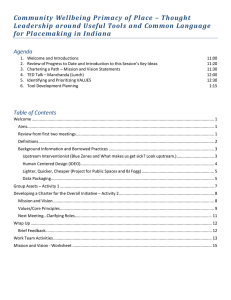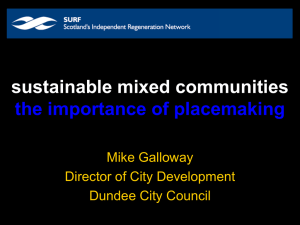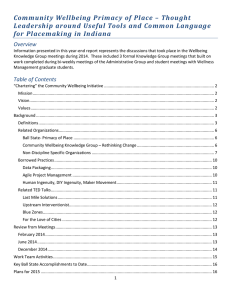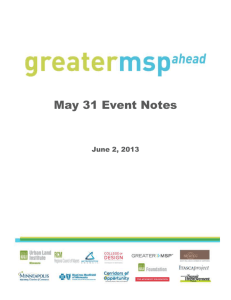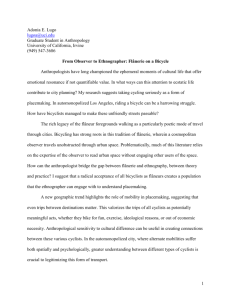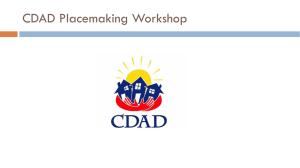Community Wellbeing Primacy of Place – Thought for Placemaking in Indiana
advertisement
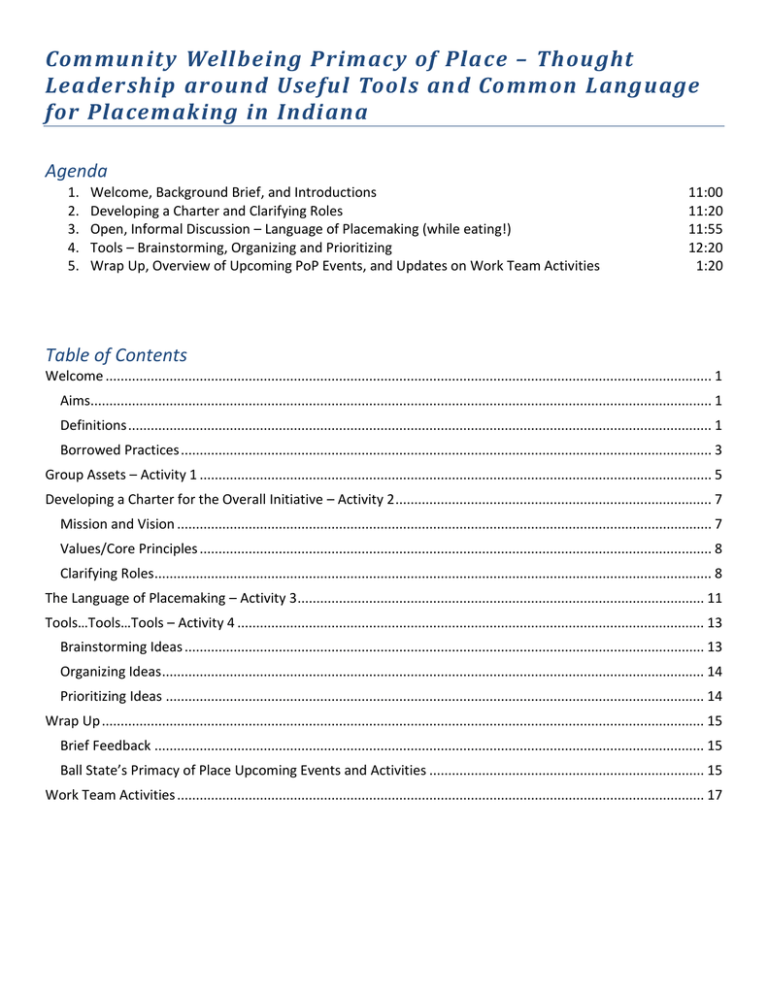
Communit y Wellbeing Primacy of Place – Thought Leadership around Useful Tools and Common Language for Placemaking in Indiana Agenda 1. 2. 3. 4. 5. Welcome, Background Brief, and Introductions Developing a Charter and Clarifying Roles Open, Informal Discussion – Language of Placemaking (while eating!) Tools – Brainstorming, Organizing and Prioritizing Wrap Up, Overview of Upcoming PoP Events, and Updates on Work Team Activities 11:00 11:20 11:55 12:20 1:20 Table of Contents Welcome ................................................................................................................................................................. 1 Aims..................................................................................................................................................................... 1 Definitions ........................................................................................................................................................... 1 Borrowed Practices ............................................................................................................................................. 3 Group Assets – Activity 1 ........................................................................................................................................ 5 Developing a Charter for the Overall Initiative – Activity 2 .................................................................................... 7 Mission and Vision .............................................................................................................................................. 7 Values/Core Principles ........................................................................................................................................ 8 Clarifying Roles.................................................................................................................................................... 8 The Language of Placemaking – Activity 3 ............................................................................................................ 11 Tools…Tools…Tools – Activity 4 ............................................................................................................................ 13 Brainstorming Ideas .......................................................................................................................................... 13 Organizing Ideas ................................................................................................................................................ 14 Prioritizing Ideas ............................................................................................................................................... 14 Wrap Up ................................................................................................................................................................ 15 Brief Feedback .................................................................................................................................................. 15 Ball State’s Primacy of Place Upcoming Events and Activities ......................................................................... 15 Work Team Activities ............................................................................................................................................ 17 Welcome Welcome to the second meeting for Ball State’s Community Wellbeing Primacy of Place initiative! Aims Three primary aims for our meeting today: 1. Use our collective, interdisciplinary intelligence to inform new thinking that we can each bring to our current work; 2. Continue movement toward an Initiative Charter (common vision); and 3. Identify and explore potential tools for both professional and citizen-based workforces. Definitions Primacy of Place – Primacy of Place represents a community’s strategic choice to dedicate resources toward placemaking and the improvement of life experiences for residents, businesses, and visitors. ALL-IN/Agile Project Management – ALL stand for ACTION, LEADERSHIP, and LIFESTYLE. ALL-IN represents the collection of tools being developed to support community engagement efforts. The concept for these tools is borrowed from the Agile Project Management practices and SCRUM used in software development. Many of these ideas are also present in Purdue University’s Strategic Doing initiative. Boundary Spanning Leadership – The Center for Creative Leadership defines boundary spanning leadership as “the capability to establish direction, alignment, and commitment across boundaries in service of a higher vision or goal (Ernst and Chrobot-Mason, 2010; Ernst and Yip, 2009). This capability resides within and across individuals, groups and teams, and larger organizations and systems” (see whitepaper at http://www.ccl.org/leadership/pdf/research/BoundarySpanningLeadership.pdf). Collective Impact – The idea that large-scale social change requires broad cross-sector coordination. (Kania and Kramer, 2011; see Stanford Social Science Review at http://www.ssireview.org/articles/entry/collective_impact). Hanleybrown, Kania, and Kramer (2012) offer a framework for collective impact by proposing 5 conditions of collective impact and sharing a chart comparing collective impact and isolated impact (see http://www.ssireview.org/blog/entry/channeling_change_making_collective_impact_work). 1 ***Citizen Workforce – Building on the concepts of person-centered and engagement, a citizen workforce represents the collective efforts of diverse individuals working together to achieve change. For this work, individuals contribute their talents toward improving the community because they are engaged members of the community and feel valued and welcomed. Human Ingenuity, DIY Ingenuity, and the Maker Movement all build on citizen workforces. Mobilizing a citizen workforce requires a relationship-driven approach that recognizes individuals as being creative and resourceful. *** 2 Borrowed Practices Agile Project Management Agile Project Management evolved from innovative software and new product development practices. It is a flexible approach that shows promise for highly complex situations. Mind Tools (http://www.mindtools.com/pages/article/agile-project-management.htm) offers insight into this practice in an article that is include in full at the end of this packet and highlighted here: What is Agile Project Management? Agile Project Management is built around a flexible approach. Team members work in short bursts on small-scale but functioning releases of a product. They then test each release against customers' needs, instead of aiming for a single final result that is only released at the end of the project. The end product of an agile project may be very different from the one that was envisaged at the outset. However, because of the checking process, team members can be sure that the product is one that customers want. This makes Agile Project Management particularly appropriate for new or fast-moving businesses, for those in a fastchanging environment, or for highly complex situations, where managers are "feeling their way forward" to find the optimum business model. It's also helpful with urgent projects that can't wait for a full, traditional project to be set up. Let's compare Agile Project Management with traditional project management to show how the approaches differ. Agile Project Management Traditional Project Management Teams are self-directed and are free to accomplish deliverables as they choose, as long as they follow agreed rules. Teams are typically tightly controlled by a project manager. They work to detailed schedules agreed at the outset. Project requirements are developed within the process as needs and uses emerge. This could mean that the final outcome is different from the one envisaged at the outset. Project requirements are identified before the project begins. This can sometimes lead to "scope creep," because stakeholders often ask for more than they need, "just in case." User testing and customer feedback happen constantly. It's easy to learn from mistakes, implement feedback, and evolve deliverables. However, the constant testing needed for this is labor-intensive, and it can be difficult to manage if users are not engaged. User testing and customer feedback take place towards the end of the project, when everything has been designed and implemented. This can mean that problems can emerge after the release, sometimes leading to expensive fixes and even public recalls. Teams constantly assess the scope and direction of their product or project. This means that they can change direction at any time in the process to make sure that their product will meet changing needs. Because of this, however, it can be difficult to write a business case at the outset, because the final outcome is not fully known. Teams work on a final product that can be delivered some time – often months or years – after the project begins. Sometimes, the end product or project is no longer relevant, because business or customer needs have changed. Ultimately, traditional project management is often best in a stable environment, where a defined deliverable is needed for a fixed budget. Agile is often best where the end-product is uncertain, or where the environment is changing fast. Human Ingenuity, DIY Ingenuity, Maker Movement People are creative, resourceful, and generous. For the past year, Robert Wood Johnson Foundation and MIT’s Little Device Lab have been working together to bring “Nurse Making” to the forefront of medical care by encouraging the resourcefulness of nurses (see http://www.rwjf.org/en/about-rwjf/newsroom/newsroomcontent/2014/02/bringing-nurse-making-to-the-forefront-of-health-care.html). In May of 2014, Time Magazine offered an article on the importance of the Maker Movement. A copy of the full article is available at the end of the packet, and a highlight is offered here: 3 Why the Maker Movement Is Important to America’s Future As someone who has seen firsthand what can happen if the right tools, inspiration and opportunity are available to people, I see the Maker Movement and these types of Maker Faires as being important for fostering innovation. The result is that more and more people create products instead of only consuming them, and it’s my view that moving people from being only consumers to creators is critical to America’s future. At the very least, some of these folks will discover life long hobbies, but many of them could eventually use their tools and creativity to start businesses. And it would not surprise me if the next major inventor or tech leader was a product of the Maker Movement. Last Mile Solutions In a 2009 TED India presentation, Behavioral Economist and MacArthur Genius Grant winner Sendhil Mullainathan “uses the lens of behavioral economics to study a tricky set of social problems — those we know how to solve, but don't. We know how to reduce child deaths due to diarrhea, how to prevent diabetesrelated blindness and how to implement solar-cell technology ... yet somehow, we don't or can't. Why?” (TED website http://www.ted.com/talks/sendhil_mullainathan). You can watch the full talk for more information, but some sections of the transcript is offered here: Solving Social Problems with a Nudge That's what I'm talking about as a last mile opportunity. You see, we tend to think the problem is solved when we solve the technology problem. But the human innovation, the human problem still remains, and that's a great frontier that we have left. This isn't about the biology of people; this is now about the brains, the psychology of people, and innovation needs to continue all the way through the last mile. See what's really puzzling and frustrating about the last mile, to me, is that the first 999 miles are all about science. No one would say, "Hey, I think this medicine works, go ahead and use it." We have testing, we go to the lab, we try it again, we have refinement. But you know what we do on the last mile? "Oh, this is a good idea. People will like this. Let's put it out there." The amount of resources we put in are disparate. We put billions of dollars into fuel-efficient technologies. How much are we putting into energy behavior change in a credible, systematic, testing way? Now, I think that we're on the verge of something big. We're on the verge of a whole new social science. It's a social science that recognizes -- much like science recognizes the complexity of the body, biology recognizes the complexity of the body -- we'll recognize the complexity of the human mind. The careful testing, retesting, design, are going to open up vistas of understanding, complexities, difficult things. And those vistas will both create new science, and fundamental change in the world as we see it, in the next hundred years. 4 Group Assets – Activity 1 Take 2 minutes to think about the Community Wellbeing Primacy of Place initiative and reflect on your favorite “work tools.” These tools may be activities, team building exercises, books, websites, technologies, organizations, meeting facilitation strategies, software packages, conferences, learning tools, colleagues, list serves, networks, reflective practices, etc. that you use regularly and that you can’t imagine having to do your job without. Please write your ideas down on paper somewhere…we will use these again later! Take 60 second to introduce yourself, share your favorite work tool, and tell us how it makes your life easier. Name Jane Ellery Favorite Tool TED Talks – encourage creativity and resourcefulness Delaina Boyd Simplexity – Teams approach that encourages the creation of teams where members have different skills including Generators, Conceptualizers, Optimizers, Implementer People and relationships. Follows Twitter feeds to get pieces of information from trusted sources rapidly Sketch Pad/Journal – important to use it to remember key items. Easier to search than notes on computer Social Trends and Urban Research searched through Research Databases and the library’s OneSearch Evernote as a technology…and the skill of LISTENING Julie Borgmann Pete Ellery Jim Connelly Kim Irwin Thalia Mulvihill Brian Blackford Krista Flynn Chris Owens Alaina Shonkwiler Computer has become an extension of the brain. Google Suite has been valuable, including Google Hangouts, Google Forms, Google Doc Google Forms has been very important…and also notes in notebook Meeting facilitation strategy that included no tables leaving individuals more open. Seemed to result in more sharing of ideas Strategies to manage conversations and get a clear understanding of individuals personal aspirations Relationship building and relationship management. Dropbox and image-based searches have also been useful 5 Developing a Charter for the Overall Initiative – Activity 2 Based on the notes from last meeting (starting point) and additional discussions today, develop a working mission and vision for our initiative. Mission and Vision Starting point: Mission – Maximize human potential through meaningful personal and professional growth and improved environments. Vision – A network of individuals who feel confident and supported as they work in their communities to co-produce changes that enhance community wellbeing. Discussion 1 – Large Group Spend 5 minutes sharing general thoughts on the Mission and Vision statements. Some brief ideas shared... like term align, needs to have community in statement, like the term coproduction (but also not a common word), maybe change individuals to leaders, embracing success, avoid “collective impact,” make clear that action is being taken, who is the target population? Discussion 2 – Pairs (5-10 minutes) Working in pairs, come to a consensus statements for both Mission and Vision statements. Completed in small groups and then used in the next discussion (not recorded) Discussion 3 – 3 Groups (10 minutes) Working in small groups, come to a consensus statements for both a Mission and a Vision statement. Write those statements on the sheet provided. Group 1 ideas: Mission: Create communities that optimize/enhance human potential for all groups through meaningful personal and professional growth and improved environments Vision: A network of individuals who strengthen assets and who are confident and supported as they work in their communities to co-produce changes that enhance community wellbeing Group 2 ideas: Mission: Optimize human potential through personal and professional growth and enhanced community environments Vision: A Network of individuals who feel confident and supported as they work in their communities to strengthen assets and co-produce changes that enhance community wellbeing Group 3 ideas: Mission: Create communities that maximize human potential for all groups through ongoing personal and professional growth in improved communities 7 Vision: A network of confident and supported leaders working to co-produce changes and maximize opportunities… that enhance community wellbeing…to emphasize community value…to make great places…to create strong communities Values/Core Principles Starting point: Key Values/Core Principles – 1. Focus on placemaking (discuss and debate place-based strategies that have potential for change) 2. Celebrate the success of others (identify and collect stories of communities that are having success to learn from their successes, to better understand the changes implemented and their impact, and to share opportunities for change with other communities) 3. Recognize both the professional and citizen workforces (identify and create tools and resources to support formal and informal personal and professional development efforts) 4. Encourage/support the use of data for decision-making (help decision-makers and community change agents understand the importance of placemaking practices and develop meaningful indicators to help monitor both change across time and outcomes related to specific initiatives) while avoiding data analysis paralysis 5. Forge partnerships to make placemaking central to a community’s economic development efforts 6. Embrace both market and core economy solutions Your July/August activity! Clarifying Roles Visual Representation of initiative groups (draft) 8 Knowledge Group Discussion to formalize the role for the Knowledge Group (5-10 minutes) Starting Point: To provide thought leadership from multiple disciplines and engage in meaningful discussions about placemaking that will allow both new knowledge and ideas for new practices to emerge. This diverse group will meet 3-4 times per year to share ideas and reflect on opportunities. This group will also refer new ideas to the Organizing Group to help the organizing group develop discussion areas for future sessions. Do we want a different name?!?!?! Others entities… Organizing Group To facilitate the activities of the initiative. This group meets 2-3 times per month to discuss activities, coordinate events, and manage communication. Work Teams To work on activities that will contribute to the collective impact. These groups will be both formally chartered and emerge naturally. Membership will be based on the specific activities. Participating Organizations and Agencies To do the work their charters encourage them to do. These groups will continue to do the work they are already engaged in while continuously evaluating opportunities to contribute to the collective impact of this initiative. 9 The Language of Placemaking – Activity 3 Your thoughts on some of the terms and practices we have been discussing. Collective Impact Citizen Workforce Placemaking Primacy of Place Co-production Agile Project Management Human Ingenuity (DIY Ingenuity) What do you like? What sounds weird? Watch use of jargon What other terms may serve us well? Quality of Place, Quality of Life Collective Intelligence (Jeff in conversation following meeting) 11 Maker Movement Wellness/Wellbeing Knowledge Group Organizing Group 12 Tools…Tools…Tools – Activity 4 Brainstorming Ideas Time - 10 minutes Revisit your favorite tools from earlier. Have other valuable tools come to mind? Spend the next 3-5 minutes reflecting on the workshops you have attended, the books you have read, the meetings you have facilitated, the trainings you have delivered, the webinars you have watched. What tools have you seen used that impressed you most? What tips/tricks have you seen used that you felt were surprisingly effective? Write these tools on sticky notes…1 tool per sticky note. Share ideas around the table (large group discussion). Please continue to write new tools that come to mind down on new sticky notes! Education/Training Tools New tools Khan Academy TED Talks (6) Mentor Partnerships Fran Butterfoss –coalition building training, web, book One-search Databases (research) For the love of Cities - Peter Kageyama (also has a TED X) (1) Project for Public Spaces (pps.org) (5) Citylab.com CommunityCommons.org MindTools.com online skill building Lynda.com Logic Models Strategic Doing National Partner Organizations (Reports, Resources) (1) Solutions Journal (2) Paper and Pen No Tables Books Fun Props Visualizations (P. Fritz) Grass Roots Communication and Gathering Places Photo Essays (2) Charitable Advisors Chart the path – define an easy next or first step for volunteers Newsletters Electronic and Printed Outlook Scheduling (2) Bulletin Boards at coffee shops, bike shops, churches, grocery “Grass Roots” groups – book clubs, lunches, community Centers (4) Cultural Competence Texting 13 Creative Problem Solving Profiles (Simplexity Thinking…Generators, Conceptualizers, Optimizers, Implementers) Testing and Measurement GIS (3) BIG DATA (Book) Google Analytics American Community Survey Survey Monkey (Testing Tools) (1) Strengths Finder 2.0 (2) Social Media Linkedin Blogs, Twitter, Facebook (6) One Note Evernote Databases YouTube Cell Phone (2) Word Press Google Suite (Hangout, Drive, Docs, etc) Organizing Ideas Time - 45 minutes Decide on organizing structure (3-5 categories) Post all of your notes under appropriate categories Discuss ideas posted under each category Prioritizing Ideas Time - 5 minutes Use stickers to vote on your top 3 general ideas…and top category Votes on general ideas and categories listed above 14 Wrap Up Brief Feedback How do you see yourself using the ideas we discussed today in your current work? Didn’t realize how much the wording mattered when you are trying to convey ideas How important it is to accurately articulate where we are going Opportunity to think “big picture” rather than having to focus on day-to-day operations Packets of information developed are very useful in bringing together terms and ideas Are you involved in activities that you think could make a good Work Team or that should be listed under our stories of success? Please forward ideas to Jane! Ball State’s Primacy of Place Upcoming Events and Activities Community Award Nominations and Recognition 2nd Annual Conference 15 Work Team Activities Project specific (defined start and end dates) Team 1 – Tool Identification and Use: Resource Repositories and Educational Opportunities Develop an online Community Wellbeing Artifact Repository related to Primacy of Place Community Wellbeing (Project 1.1) Plan workshop sessions… maybe Power of 10 or HIA training…focus on using tools for change (Project 1.2) Develop a Scholarly Repository related to Primacy of Place Community Wellbeing (Ball State Documents) in the library (Project 1.3) Team 2 – Tool Development: Communicating around PoP Create a tool/presentation to communicate Primacy of Place focus that can be used by members of the group to share the messages of placemaking (Project 2.1) Create Agile project management tools for use in our initiative (Project 2.2) Team 3 – Professional Development and Data Use: Shared Measurement Develop a proposal for the HIA Grant cooperative agreement RFP @ CDC (Project 3.1) Identify useful placemaking variables (Project 3.2) Team 4 – Placemaking focus: Festival Planning (community pride) Plan Muncie community festival (Project 4.1) Team 5 – New ways of doing: Student Research and Writing Develop a research agenda for which students from both the EdD and DNP programs can contribute (Project 5.1) Develop a whitepaper related to valuing core economy (5.2) 17 Jane’s Reflection on Mission/Vision Activity Bringing ideas shared during the activity and my “take away” from various conversations throughout the day I would like to propose the Mission and Vision statements listed below for the overall Primacy of Place Community Wellbeing initiative. I feel these statements capture the essence of the ones generated during our activity as well as some salient points I heard people mention throughout our meeting time. I also think the reformatting helps identify our broad target audience (leaders both formal and informal) and helps establish a slightly more focused path forward. Mission – The mission of the Primacy of Place Community Wellbeing initiative is to develop a network of confident and supported leaders who are working to create great places for people to live, work, and play by strengthening community assets and co-producing wellbeing-enhancing change for people from diverse groups. Vision – This network will encourage innovative community change resulting in thriving people in vibrant communities throughout Indiana. Definitions (still to come!): Leaders Great Places Community Assets Co-production Thrive Vibrant Next meeting… Key Values/Core Principles: Starting point: 1. Focus on placemaking (discuss and debate place-based strategies that have potential for change) 2. Celebrate the success of others (identify and collect stories of communities that are having success to learn from their successes, to better understand the changes implemented and their impact, and to share opportunities for change with other communities) 3. Recognize both the professional and citizen workforces (identify and create tools and resources to support formal and informal personal and professional development efforts) 4. Encourage/support the use of data for decision-making (help decision-makers and community change agents understand the importance of placemaking practices and develop meaningful indicators to help monitor both change across time and outcomes related to specific initiatives) while avoiding data analysis paralysis 5. Forge partnerships to make placemaking central to a community’s economic development efforts 6. Embrace both market and core economy solutions Path forward for the Knowledge Group (including a new name if we want!): 18 Starting Point: To provide thought leadership from multiple disciplines and engage in meaningful discussions about placemaking that will allow both new knowledge and ideas for new practices to emerge. This diverse group will meet 3-4 times per year to share ideas and reflect on opportunities. This group will also refer new ideas to the Organizing Group to help the organizing group develop discussion areas for future sessions. 19
